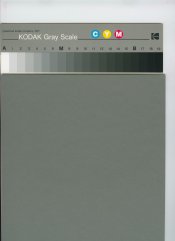- Joined
- Jan 10, 2010
- Messages
- 60
- Format
- Medium Format
Epson Perfection 4870 Photo.
Silverfast Ai Studio 8.8r25
Windows 10 64bit.
I calibrated the scanner using an IT8 Target from Wolf Faust.
The Silverfast IT8 software created a new Input icc profile:-

When I scan the IT8 target, the colour balance looks fine when viewed on my Eizo calibrated monitor.
There is no color cast evident in the neutral grey border.
If I try a scanning a Kodak grey card at the same time, the grey card has a very obvious green cast.
When the originals are viewed next to each other in daylight, the greys both appear virtually idenitical.
The scanner apparently registers the light reflected from the surface of the grey card differently to the human eye.
If I measure the grey card using a refelective densitometer, I get almost equal readings for the R,G,B densities.
I have also tried using the Epson scanning software (using it's own Epson input profiles). I get a similar result.
Can anyone explain why the scanned grey card image looks so different to the original?
I can understand why there could be a slight difference - matt vs glossy surface etc. but I did not expect it to look this bad.

Silverfast Ai Studio 8.8r25
Windows 10 64bit.
I calibrated the scanner using an IT8 Target from Wolf Faust.
The Silverfast IT8 software created a new Input icc profile:-
When I scan the IT8 target, the colour balance looks fine when viewed on my Eizo calibrated monitor.
There is no color cast evident in the neutral grey border.
If I try a scanning a Kodak grey card at the same time, the grey card has a very obvious green cast.
When the originals are viewed next to each other in daylight, the greys both appear virtually idenitical.
The scanner apparently registers the light reflected from the surface of the grey card differently to the human eye.
If I measure the grey card using a refelective densitometer, I get almost equal readings for the R,G,B densities.
I have also tried using the Epson scanning software (using it's own Epson input profiles). I get a similar result.
Can anyone explain why the scanned grey card image looks so different to the original?
I can understand why there could be a slight difference - matt vs glossy surface etc. but I did not expect it to look this bad.





